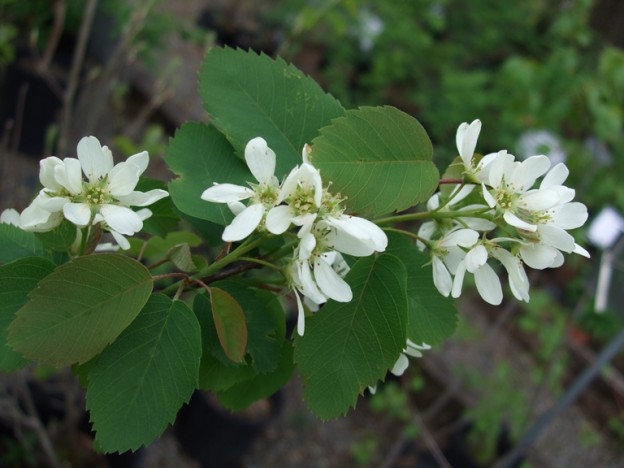Saskatoon Serviceberry The Rose Family–Rosaceae
Amelanchier alnifolia (Nutt.) Nut. ex M. Roem
(am-el-ang-KEY-er aln-IH-foal-ee-uh)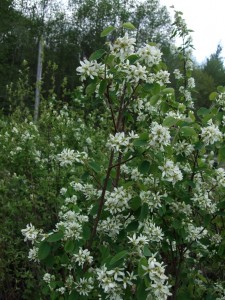
Names: Saskatoon Serviceberry is a combination of two of its most familiar common names. It is also known as Juneberry, or Western Serviceberry. Historically it was also called “pigeon berry.” In some regions, serviceberry is pronounced “sarvis”-berry. Saskatoon comes from the Cree word for Serviceberry. The city of Saskatoon, Saskatchewan was named after the berry. The name “serviceberry” apparently comes from the similarity of the fruit to the related European Sorbus. The origin of the generic name Amelanchier is derived from the French name of the European species, Amelanchier ovalis. Alnifolia means “alder-like” leaves.
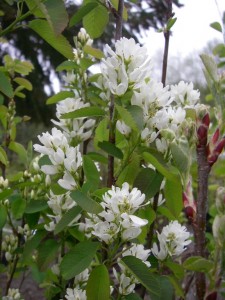 Relationships: There are about 20 species of Amelanchier, all shrubs or small trees. Most are native to North America with two in Asia and one in Europe. In some literature, Saskatoon Serviceberry is listed as Amelanchier florida. Notable varieties in the west include var. semiintegrifolia (Douglas, quoted in Hitchcock & Cronquist, writes that it is “plentiful about the Grand Rapids, and at Fort Vancouver, on the Columbia, and on the high ground of the Multnomak (sic) River.;” var. cusickii from the east side of the Cascades has larger flowers; and var. humptulipensis was discovered on the Humptulips Prairie in Grays Harbor County, Washington. Serviceberries hybridize readily making species identification sometimes difficult. Cultivated varieties are grown for larger, sweeter berries, especially in Alberta, Saskatchewan, and Manitoba.
Relationships: There are about 20 species of Amelanchier, all shrubs or small trees. Most are native to North America with two in Asia and one in Europe. In some literature, Saskatoon Serviceberry is listed as Amelanchier florida. Notable varieties in the west include var. semiintegrifolia (Douglas, quoted in Hitchcock & Cronquist, writes that it is “plentiful about the Grand Rapids, and at Fort Vancouver, on the Columbia, and on the high ground of the Multnomak (sic) River.;” var. cusickii from the east side of the Cascades has larger flowers; and var. humptulipensis was discovered on the Humptulips Prairie in Grays Harbor County, Washington. Serviceberries hybridize readily making species identification sometimes difficult. Cultivated varieties are grown for larger, sweeter berries, especially in Alberta, Saskatchewan, and Manitoba.
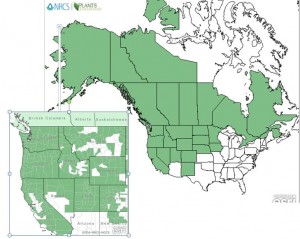
Distribution of Saskatoon Serviceberry from USDA Plants Database
Distribution: Saskatoon Serviceberry is found throughout most of Canada and western North America; from Alaska to California in the west; reaching eastward in Canada to Quebec; to western Colorado and northern Nebraska and Iowa in the United States.
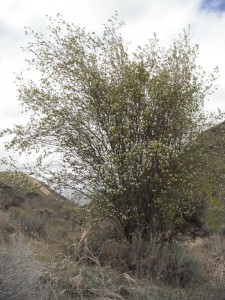 Growth: Saskatoon Serviceberry grows 3-15 ft. (1-5m) tall, sometimes taller. It is relatively short-lived; most will live about 20 years but some have survived to 85.
Growth: Saskatoon Serviceberry grows 3-15 ft. (1-5m) tall, sometimes taller. It is relatively short-lived; most will live about 20 years but some have survived to 85.
Habitat: It grows in a variety of habitats from rocky shorelines, stream banks, and open forests to prairies and dry mountain slopes. Wetland designation: FACU, It usually occurs in non-wetlands, but occasionally is found on wetlands.
Diagnostic Characters: The thin, round leaves of Saskatoon Serviceberry are entire (not toothed) at the base and regularly toothed along the upper margin. The showy flowers are white and star-like. The ripe fruit is a small berry-like pome; dark, reddish purple to nearly black.
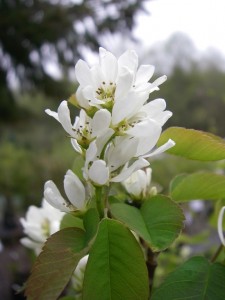
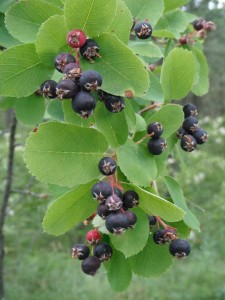
In the Landscape: Serviceberry is an outstanding landscape plant. Not only is it attractive through every season, it has the bonus of producing edible fruit. In spring, it is loaded with bright, star-like white blossoms. In late summer, it produces clusters of purplish-black little “apples;” soon followed by the changing of the leaves to yellow or red in autumn. An attractive branching pattern adds winter interest. It grows in sun or partial shade; and is superb in an open woodland garden or on a sunny bank.
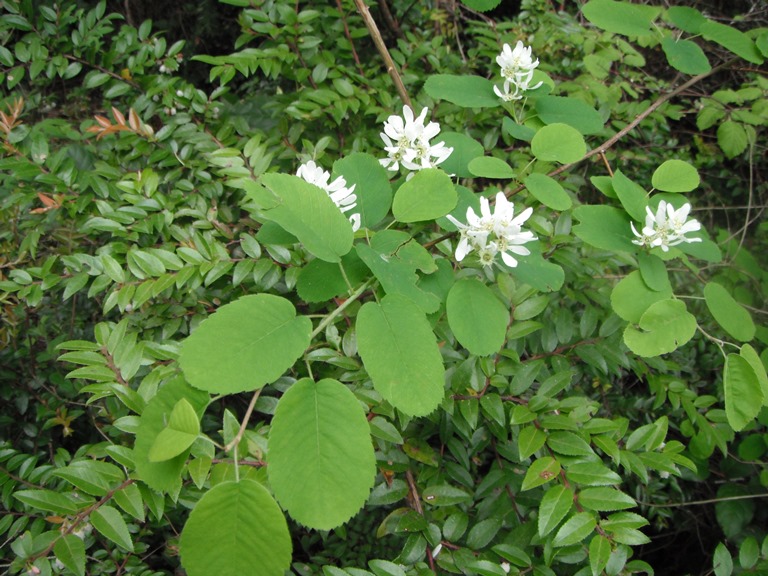
Phenology: Bloom time: May-June. Fruit ripens: July-August.
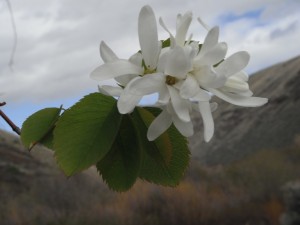
Propagation: Seeds require a cold stratification for 180 days at 40ºF (4ºC). “Green” seeds that are harvested before they are fully formed and the seed coat has hardened may require less time. Stored seed may benefit from a warm stratification period for 4 weeks prior to the cold stratification; otherwise seeds may take 18 months or more to germinate. Suckers that have roots may be divided from the mother plant. Layering is possible but it may take 18 months for roots to grow sufficiently.
 Use by People: Natives ate the fruit fresh and dried; some used it to season soup or meat. Some tribes used burning to encourage stands of Saskatoon; it will resprout from the root crown or rhizomes after the top is killed by fire and may fruit again after two years. Interior tribes used the tough wood for arrows, digging sticks, and drying racks. Coastal tribes used it for rigging their halibut lines. The Snohomish used the wood to make discs for a gambling game called slahalem. In early American folklore, the plant’s flowering time signaled pioneers that the ground had thawed enough in spring for the burial of the winter’s dead. Today people use the fruit for making pastries, jellies and syrups.
Use by People: Natives ate the fruit fresh and dried; some used it to season soup or meat. Some tribes used burning to encourage stands of Saskatoon; it will resprout from the root crown or rhizomes after the top is killed by fire and may fruit again after two years. Interior tribes used the tough wood for arrows, digging sticks, and drying racks. Coastal tribes used it for rigging their halibut lines. The Snohomish used the wood to make discs for a gambling game called slahalem. In early American folklore, the plant’s flowering time signaled pioneers that the ground had thawed enough in spring for the burial of the winter’s dead. Today people use the fruit for making pastries, jellies and syrups.
Use by Wildlife: Saskatoon serviceberry is a valuable wildlife plant. Many species of rodents and songbirds eat the fruits, including chipmunks, crows, thrushes, robins and Western Tanagers. Black Bears, beaver, marmots, and hares eat twigs, foliage, fruits and bark. Moose elk, and deer, especially Mule Deer, browse the twigs and foliage; however due to the high concentration of cyanogenic glycosides in young twigs, a diet consisting of more than 35% Saskatoon Serviceberry may be fatal.
Links:
Consortium of Pacific Northwest Herbaria
WTU Herbarium Image Collection, Plants of Washington, Burke Museum
E-Flora BC, Electronic Atlas of the Flora of British Columbia
Jepson Eflora, University of California
Ladybird Johnson Wildflower Center
USDA Forest Service-Fire Effects Information System
Native Plants Network, Propagation Protocol Database
Native American Ethnobotany, University of Michigan, Dearborn
Dwarf Serviceberry
Amelanchier pumila (Torr. & A. Gray) Nutt. ex M. Roem.
This species is often listed as a variety of Saskatoon Serviceberry (A. alnifolia var. pumila) and is very similar except for its smaller stature (pumila means dwarf) and smoother, less fuzzy flowers and leaves. It grows 3-6 feet (1-2m) tall. Its leaves are somewhat leathery. In Washington, it is more common on the eastern slopes of the Cascades; its range extending through the Sierras of California, eastward to western Montana and northwestern New Mexico. Dwarf Serviceberry is at home on drier mountain slopes and open prairies.
Links:
Consortium of Pacific Northwest Herbaria

